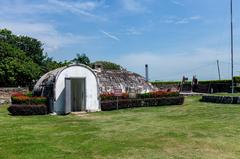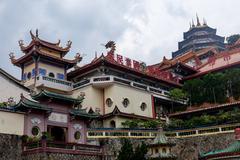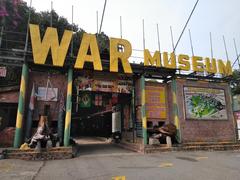Nattukkottai Chettiar Temple: Visiting Hours, Tickets & Comprehensive Visitor Guide
Date: 04/07/2025
Introduction
The Nattukkottai Chettiar Temple, also known as Arulmigu Balathandayuthapani Kovil or Waterfall Hill Temple, stands as one of Penang’s most prominent Hindu landmarks. Renowned for its architectural splendor, deep-rooted cultural significance, and vibrant festivals, the temple serves as both a spiritual sanctuary and a community hub for Penang’s Tamil Chettiar community. Established in 1854, this historical site not only embodies South Indian Chettinad architectural traditions but also plays a pivotal role in Penang’s multicultural landscape (wedresearch.net; scroll.in).
This guide provides an in-depth look at the temple’s origins, architecture, religious practices, visitor information, major festivals, and practical tips, ensuring an enriching experience for all visitors.
Historical Background and Community Significance
Origins of the Nattukkottai Chettiar Community
The Nattukkottai Chettiars, or Nagarathars, hail from Tamil Nadu’s Sivagangai and Pudukottai districts. Historically, they were influential merchants and bankers whose migration to Southeast Asia, including Penang, was propelled by British colonial expansion and burgeoning trade opportunities in the early 19th century (scroll.in). Their presence in Penang from the 1840s marked the establishment of a vibrant community that combined faith, enterprise, and philanthropy.
Establishment of the Nattukkottai Chettiar Temple
Constructed in 1854 on Waterfall Road (Jalan Kebun Bunga), the temple was among the earliest religious landmarks for the Chettiar community in Malaysia (wedresearch.net). Dedicated to Lord Murugan, the temple was established with guidance from religious authorities who encouraged the community to build Murugan temples abroad due to ritual constraints on Shiva worship outside India. The temple quickly became a spiritual and social anchor for the Chettiars in Penang.
Economic and Social Role
Throughout its history, the temple served not only as a place of worship but also as a financial and cultural hub. It was a center for business discussions, community gatherings, and philanthropic initiatives, with temple funds often reinvested in local businesses, reinforcing community bonds and fostering social cohesion (scroll.in).
Architectural and Artistic Highlights
Architectural Layout
The temple is a fine example of the traditional “chokkattan” (plus-shaped) layout typical of Chettinad temples. Its sanctum sanctorum (garbhagriha) is oriented eastward, symbolizing spiritual awakening. The structure features a wooden superstructure and pillars made of Burmese teak, renowned for its durability and warm golden hue (eribi.gov.my; temple-indian.my).
Decorative Elements
The temple’s ceilings and walls are adorned with hundreds of mythological paintings imported from India, depicting scenes from Hindu epics and legends. The gopuram (gateway tower) is decorated with intricately painted sculptures of deities, while the mandapam (entrance hall) boasts ornate floral and geometric motifs characteristic of Chettinad artistry (harmonico.my; academia.edu).
Symbolism
Every element of the temple’s design carries spiritual symbolism. The east-facing sanctum, double courtyards, rainwater-collecting roofs, and elaborate entrance porches reflect both ritual significance and adaptation to Penang’s tropical climate (academia.edu).
Religious Practices and Festivals
Daily Rituals
Daily pujas and abhishekams are performed in Tamil and Sanskrit, with offerings of fruits, flowers, milk, and saffron water. The temple encourages participation and inclusivity for visitors of all backgrounds.
Thaipusam Festival
Thaipusam, held during the Tamil month of Thai (January/February), is the temple’s most significant annual festival. It honors Lord Murugan’s victory over evil and draws over 200,000 devotees and visitors. Key events include:
- Silver Chariot Procession: From Sri Mahamariamman Temple in George Town to the Chettiar Temple.
- Kavadi Attam: Devotees carry ornate kavadis and perform acts of penance.
- Pilgrimage Climb: 513 steps to the hilltop temple, symbolizing spiritual ascent.
- Offerings and Feasts: Ritual offerings, communal meals, and festive celebrations (penang.com).
Other Festivals
- Masi Magam (February/March): Ritual processions and symbolic immersions.
- Varusha Pirappu (Tamil New Year, April): Prayers and community gatherings.
- Deepavali: Special pujas, decorations, and food distribution.
Visiting Information
Opening Hours
- Standard Hours: 6:00 AM – 8:00 PM daily (trip.com).
- Festival Hours: Extended during major festivals such as Thaipusam.
- Additional Note: Some sources list precise timings as 6:15 AM – 12:30 PM and 4:15 PM – 8:45 PM. Always check before visiting during festival periods.
Tickets and Entry
- Admission: Free for all visitors. Donations are welcome to support maintenance and charitable activities.
Accessibility
- Physical Access: The lower temple complex is wheelchair accessible, with ramps at key entrances. The hilltop temple requires climbing over 500 steps.
- Facilities: Restrooms, shaded areas, footwear storage, and drinking water available. Vegetarian meals may be served during festivals.
Getting There
- Location: Jalan Kebun Bunga (Waterfall Road), George Town, Penang.
- Transport: Accessible via taxi, bus, private car. Parking is available but limited during festivals. The Penang Hill funicular railway is nearby.
Visitor Experience and Etiquette
- Dress Code: Modest attire covering shoulders and knees. Remove shoes before entering temple buildings.
- Photography: Permitted in outer courtyards; prohibited in the main sanctum. Always ask before photographing rituals or devotees.
- Behavior: Maintain a respectful demeanor, avoid touching icons or offerings, and follow the flow of devotees.
- Guided Tours: Available by request through temple management or local tourism operators. Informational plaques are present in English and Tamil.
Nearby Attractions
- Penang Botanic Gardens: Adjacent to the temple, ideal for a nature stroll.
- Penang Hill: Offers panoramic views and the funicular railway.
- Sri Mahamariamman Temple: Starting point of the Thaipusam procession.
- George Town Heritage Area: Renowned for its UNESCO World Heritage status, colonial architecture, and street art.
Practical Tips
- Visit early in the morning or late afternoon for a quieter experience.
- During Thaipusam, expect large crowds and vibrant festivities.
- Bring sun protection and a reusable water bottle.
- Participate in communal meals if available.
- Learn simple Tamil greetings (e.g., “Vanakkam”) for a warm interaction.
Frequently Asked Questions (FAQ)
Q: What are the visiting hours?
A: Generally 6:00 AM to 8:00 PM daily; verify during festivals.
Q: Is there an entry fee?
A: No, entry is free. Donations are welcome.
Q: Is the temple wheelchair accessible?
A: Lower complex is accessible; access to the hilltop requires climbing stairs.
Q: Are guided tours available?
A: Yes, by prior arrangement with temple management or local tour operators.
Q: Can I take photographs?
A: Yes, except in the main sanctum and during certain rituals.
Q: When is the best time to visit?
A: Thaipusam (January/February) for festivals; weekdays for a tranquil experience.
Visual Media
For a richer experience, explore photo galleries and interactive maps on tourism portals. Suggested alt text for images:
- “Nattukkottai Chettiar Temple gopuram in Penang”
- “Intricate Burmese teak carvings at Nattukkottai Chettiar Temple”
- “Thaipusam festival procession at Nattukkottai Chettiar Temple”
Summary and Call to Action
The Nattukkottai Chettiar Temple encapsulates Penang’s multicultural spirit through its stunning Chettinad architecture, vibrant festivals, and deep community roots. Whether you’re drawn by its history, artistry, or religious significance, the temple promises a meaningful visit.
For updated information on visiting hours, events, and tours, download the Audiala app and follow the temple’s official social media channels. Embark on your journey to Penang’s cultural heart and share in the living heritage of the Nattukkottai Chettiar community.
References and Further Reading
- Nattukkottai Chettiar Temple in Penang: History, Visiting Hours, Tickets, and Cultural Significance (wedresearch.net)
- An Indian Community’s Journey to Becoming a Major Financial Player in Singapore and Malaysia (scroll.in)
- Visiting Nattukkottai Chettiar Temple: Festivals, History, and Travel Tips in Penang (penang.com)
- Nattukkottai Chettiar Temple Architecture and Artistry (eribi.gov.my)
- Nattukkottai Chettiar Temple Visitor Information (trip.com)
- Nattukkottai Chettiar Temple Cultural Insights (harmonico.my)
- Chettinad Architecture and Culture (academia.edu)








